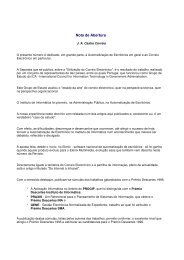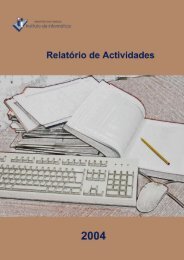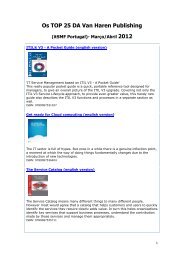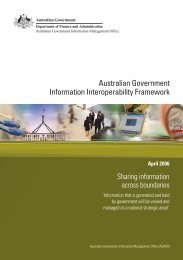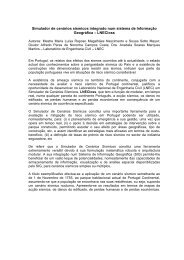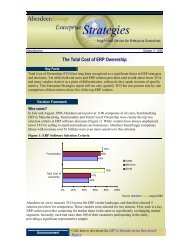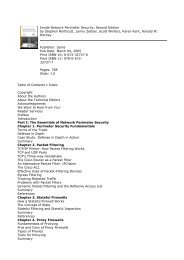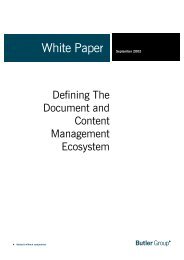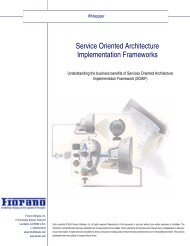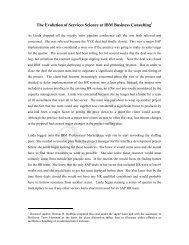OECD Peer Review of E-Government in Denmark - ePractice.eu
OECD Peer Review of E-Government in Denmark - ePractice.eu
OECD Peer Review of E-Government in Denmark - ePractice.eu
Create successful ePaper yourself
Turn your PDF publications into a flip-book with our unique Google optimized e-Paper software.
The Task Force has <strong>in</strong>itiated a project focused on us<strong>in</strong>g ICT to improve the exchange <strong>of</strong><br />
<strong>in</strong>formation with<strong>in</strong> a health-sector “service community” compris<strong>in</strong>g hospitals and municipalities. This<br />
is another example <strong>of</strong> the type <strong>of</strong> <strong>in</strong>itiative that can drive organisational change through improved<br />
<strong>in</strong>formation shar<strong>in</strong>g. The project, which began <strong>in</strong> 2002, facilitates more unified treatment <strong>of</strong> patients<br />
by improv<strong>in</strong>g digital communication between municipalities and hospitals related to hospitalisation<br />
and discharge <strong>of</strong> patients. The project focuses on improv<strong>in</strong>g the exchange <strong>of</strong> <strong>in</strong>formation about patient<br />
contact addresses between municipalities and hospitals at the time <strong>of</strong> hospitalisation. Similar<br />
<strong>in</strong>itiatives have been put <strong>in</strong> place <strong>in</strong> various areas <strong>of</strong> e-government (e.g. e-Agriculture, e-Bus<strong>in</strong>ess).<br />
Impact on organisational structure<br />
The use <strong>of</strong> ICT <strong>in</strong> government <strong>of</strong>ten cuts across core functions such as plann<strong>in</strong>g, budget<strong>in</strong>g,<br />
human resource management. This provides opportunities for government to reshape exist<strong>in</strong>g<br />
organisational structures and reth<strong>in</strong>k traditional frameworks <strong>of</strong> responsibilities. Just over 50% <strong>of</strong><br />
respondents to the <strong>OECD</strong> survey <strong>in</strong>dicated that e-government has had an impact on the def<strong>in</strong>ition <strong>of</strong><br />
such functions and responsibilities.<br />
However, <strong>in</strong>ternal organisational rigidities seem to be reduc<strong>in</strong>g e-government’s ability to create<br />
more flexible organisational structures. A review <strong>of</strong> major barriers to e-government <strong>in</strong> <strong>Denmark</strong><br />
conducted by the Digital Task Force <strong>in</strong> 2003 identified a “bunker” (or silo) culture as one <strong>of</strong> the key<br />
obstacles to the development <strong>of</strong> e-government <strong>in</strong> <strong>Denmark</strong>. This issue is, <strong>of</strong> course, not unique to<br />
<strong>Denmark</strong>. Throughout <strong>OECD</strong> countries, the silo structure <strong>of</strong> government organisations is widely<br />
considered to be an obstacle to communication among agencies which prevents <strong>in</strong>ter-organisational<br />
th<strong>in</strong>k<strong>in</strong>g and action – specifically <strong>in</strong> the development <strong>of</strong> e-government, and more widely <strong>in</strong> the<br />
development and delivery <strong>of</strong> policies, programmes and services. Some steps be<strong>in</strong>g taken to address<br />
this problem through support<strong>in</strong>g <strong>in</strong>creased levels <strong>of</strong> collaboration between government organisations<br />
are discussed <strong>in</strong> Chapter 6.<br />
The Task Force’s review <strong>in</strong>dicated two major barriers to the organisational change ultimately<br />
required for effective e-government <strong>in</strong> <strong>Denmark</strong>: 1) the absence <strong>of</strong> a culture that promotes staff<br />
mobility and task reallocation across organisations; 2) a lack <strong>of</strong> <strong>in</strong>centives for organisations to<br />
participate <strong>in</strong> cross-cutt<strong>in</strong>g projects. This is particularly true at the State government level, where the<br />
Structural Reform process will have the least impact. A survey conducted by the M<strong>in</strong>istry <strong>of</strong><br />
Education also <strong>in</strong>dicated that the biggest impact <strong>of</strong> ICT on organisational change <strong>in</strong> government is<br />
considered by <strong>of</strong>ficials to be on improv<strong>in</strong>g the level <strong>of</strong> employees’ skills, rather than on chang<strong>in</strong>g<br />
organisational structures. This is further evidence that e-government has had only limited impact on<br />
organisational structures.<br />
The <strong>OECD</strong> survey results show that e-government has also had an impact on the reduction <strong>of</strong><br />
staff costs (slightly more than 40% <strong>of</strong> respondents <strong>in</strong>dicated such an impact). The <strong>in</strong>troduction <strong>of</strong><br />
electronic archiv<strong>in</strong>g and document management has freed resources and brought staff reductions <strong>in</strong><br />
some m<strong>in</strong>istries, though is it not clear whether these <strong>in</strong>dividuals have been reallocated or made<br />
redundant.<br />
Impact on organisational processes<br />
In addition to affect<strong>in</strong>g organisational structures, the use <strong>of</strong> ICT can have a positive impact on<br />
organisational processes by speed<strong>in</strong>g them up, reduc<strong>in</strong>g errors and elim<strong>in</strong>at<strong>in</strong>g duplication, enabl<strong>in</strong>g<br />
process re-eng<strong>in</strong>eer<strong>in</strong>g (both with<strong>in</strong> and across organisations) and generally enhanc<strong>in</strong>g process<br />
automation. More than 70% <strong>of</strong> <strong>OECD</strong> survey respondents stated that e-government has had an impact<br />
on both front- and back-<strong>of</strong>fice bus<strong>in</strong>ess processes. Interviews with <strong>of</strong>ficials revealed that a large<br />
82



